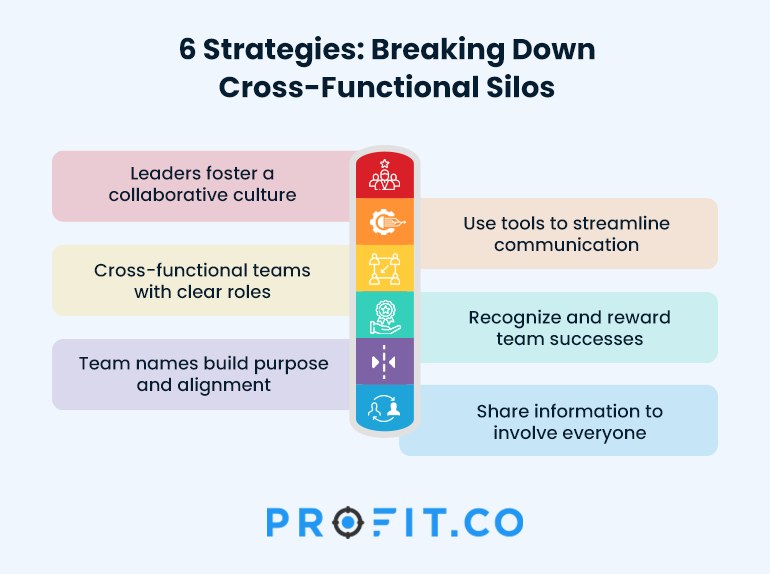We’ve all heard about them, and most have worked within them. They’re like invisible walls that form between departments, keeping information, ideas, and people isolated. It’s not necessarily intentional, but it’s a natural byproduct of specialization. Marketing does marketing things. Sales do sales things. Operations…well, you get it.
In today’s ever-evolving world, the catch is silos are not just inconvenient but downright dangerous. They slow down innovation, waste resources, and leave organizations playing catch-up while competitors zoom ahead.
So, how do we handle this? How do we break through those walls and build a workplace where ideas flow freely and collaboration thrives? The answer is in cross-functional collaboration a strategy that’s a combination of art, part science, and entirely necessary. Breaking down those silos is critical. Stay tuned to see how.
Why Do Silos Exist in the First Place?
Silos happen because departments naturally focus on their specific goals. Marketing might be chasing brand awareness, while IT is focused on system stability. Each team develops deep expertise in its area, which is great until they stop communicating with each other.
Add to that leadership behaviors that reward departmental performance over organizational success, and you have a recipe for inefficiency. Teams protect their resources, keep their knowledge close, and focus on their KPIs, often at the expense of the big picture.
However, we all know that no department is an island. Every function in an organization touches another in some way. Silos might feel comfortable, but they block the collaboration necessary to innovate and solve big problems.
Alone we can do so little; Together we can do so much.
What Happens When Silos Stay Up?
Let’s be real silos don’t just slow things down. They actively cause harm. Here’s what happens when those walls stay standing:
- Duplication of Effort: Teams unknowingly work on the same tasks, wasting time and resources.
- Communication Breakdowns: Misaligned priorities and poor information flow lead to confusion and missed opportunities.
- Stifled Innovation: Without input from diverse perspectives, ideas get stuck in an echo chamber, and creativity takes a hit.
- Poor Decision-Making: Teams make choices based on limited information instead of considering the bigger picture.
In short, silos prevent organizations from reaching their full potential. And that’s a shame because cross-functional collaboration can fix all of that.

Why Cross-Functional Teams Are the Future
When teams from different departments work together, real progress happens. Cross-functional collaboration improves communication, drives innovation, speeds up decision-making, and makes organizations more agile.
Here’s why it works:
- Diverse Perspectives: Bringing together people with different skills and expertise leads to better problem-solving. A marketer thinks differently from a product manager, who thinks differently from an engineer. Together, they see the full picture.
- Faster Solutions: With everyone at the table, issues get addressed quickly. There’s no need for endless back-and-forth emails or meetings to “loop someone in.”
- Better Alignment: Cross-functional teams focus on shared goals, breaking the cycle of “us vs. them” and creating a culture of unity.
Take the first step toward cross-functional success. Explore strategies to align your teams now!
Strategies to Break Down Silos
Ready to get started? Here’s are some ideas on how you can foster cross-functional collaboration in your organization:
1. Build Bridges From the Top
Leadership sets the tone for collaboration. When executives model cross-functional behaviorlike bringing teams together for joint projects or openly sharing information it trickles down to the rest of the organization. Leaders who act as connectors help align departments with company goals and create opportunities for employees to widen their horizons. Encouraging collaboration at the highest levels paves the way for a more unified, agile organization.
2. Create Cross-Functional Projects
One of the best ways to break down silos is to get teams working together on real, meaningful projects. But here’s the trick: these can’t feel like “extra” work. Collaboration must be baked into people’s roles and responsibilities, with clear goals and measurable outcomes.
3. Name It to Unite It
Sometimes, a simple rebrand can make a big difference. Giving cross-functional teams a name or identity creates a sense of belonging and purpose. For example, one company turned its operations division into “OAK” (Owned Assets of KOA), symbolizing strength and unity.
The name “OAK” was chosen intentionally it symbolizes strength, growth, and interconnectedness, much like the branches of an oak tree. This rebranding gave the division a unified identity, making it clear that these teams worked together toward shared goals, not just handling their separate tasks.
4. Use Technology to Connect Teams
Technology plays a crucial role in breaking down silos and fostering collaboration. Communication and project management tools help centralize information, streamline workflows, and ensure everyone stays aligned regardless of their team or location. Organizations can improve visibility, enhance coordination, and keep everyone working toward shared goals by using the right platforms.
5. Recognize and Reward Collaboration
If you want people to work together, show them it’s valued. Shift recognition away from individual achievements and celebrate team successes. A shoutout in a meeting, a team lunch, or even a simple “well done” email can go a long way. When people see that collaboration is valued, they want to do it more. And that’s how you turn “me” into “we.”
6. Keep Everyone Informed
Good communication is the foundation of cross-functional collaboration. At the end of every meeting or project, ask: Who needs to know about this? Who’s missing from the conversation? This simple step ensures no one feels left out and helps align efforts across the organization.
The Benefits of Collaboration
So, what happens when you break down silos and foster cross-functional teamwork? Here’s what you can expect:
- Stronger Innovation: Diverse ideas lead to breakthrough solutions.
- Increased Efficiency: Teams work smarter, not harder, by pooling resources and avoiding duplication.
- Happier Employees: When people feel connected and valued, morale skyrockets.
- Better Decisions: With input from all sides, you’ll make choices that benefit the whole organization not just one department.
The Bottom Line
Breaking down silos isn’t easy. It takes effort, intentionality, and a willingness to change how things have always been done. But the payoff? It’s worth it.
When teams work together, they don’t just complete projects they create value. They innovate, adapt, and build a culture where everyone wins.
So, what’s stopping you? Let’s tear down those walls and start collaborating. Because the future of work isn’t about departments it’s about people working together to achieve something more significant.

